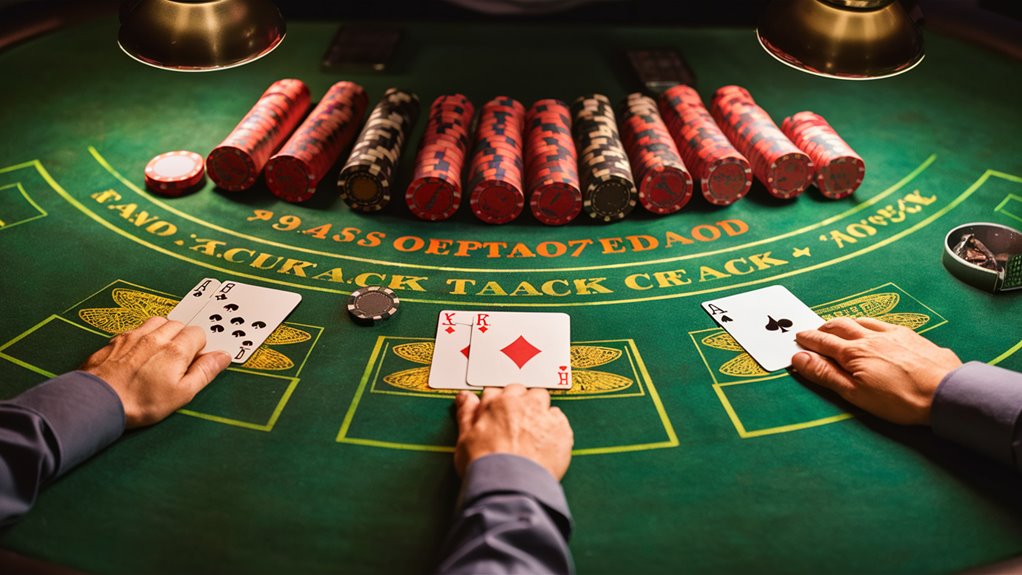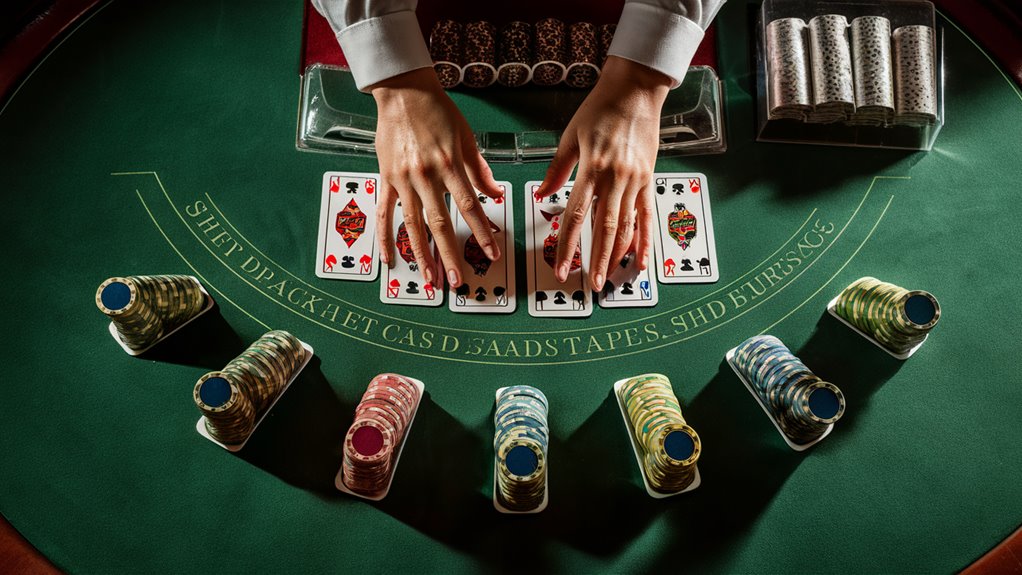The Simple Rules of Blackjack: Needed Know-How for Winning

Basic Math
Blackjack odds are based on clear-cut math: 30.77% ten-value cards, 7.69% aces, and 61.54% number cards. Knowing these key rates sets the base for smart playing and smart choices.
Smart Plays
Using basic methods cuts the house edge from 2.7% to 0.5%. Top players who use card counting like Hi-Lo may up their lead by up to 1.5% by keeping track of high and low cards.
Managing Your Money
Winning at blackjack calls for strict money control. Pros keep 100-200 bets in their pool to keep their chance of going broke under 1% over 1,000 hands. This math method keeps play going and helps you last in the long run. 토토사이트 순위
Top-Level Choices
Knowing 250+ unique cases via deep odds analysis turns blackjack from a luck game into a system of getting an edge. Mixed with smart bet ways and ongoing odds checks, players can boost their expected win each game.
The Science Edge
Among casino games, blackjack is unique because it can be solved by math, letting skilled players get a stats lead by using smart strategies and good system plays.
Basic Odds and Stats
Card odds are key for doing well at blackjack. In a regular 52-card deck, ten-value cards (10s, Jacks, Queens, Kings) make up 30.77% of it, and aces are 7.69%. The other number cards (2-9) are 61.54% of the deck.
Changing Odds Study
Odds shift during play as cards show up. Watching which cards come up is key, especially the high-value ones.
The first blackjack odds of 4.83% change as tens and aces leave the game, deeply affecting game choices.
Higher Math Steps
If-Then odds are big in making the best play choices. Players must judge the chance of a better hand based on their cards and the dealer’s shown card.
Outcome weights guide choices by putting possible results against their odds, making a math frame for good basic strategy.
Key Odds Points:
- Ten-value cards: 16/52 (30.77%)
- Aces: 4/52 (7.69%)
- Number cards: 32/52 (61.54%)
- Starting blackjack odds: 4.83%
The Basics of Card Counting
Guide to Card Counting Basics: A Full Guide
Getting to Know the Hi-Lo Way
Card counting works on a smart math tracking system made just for blackjack. The Hi-Lo counting way gives points to cards: low cards (2-6) get a +1, neutral cards (7-9) get 0, and high cards (10-Ace) get -1. Spaces Affect Customer Satisfaction
This careful tracking checks deck mix and favorability by stats.
From Count to True Count
The running count turns into a more exact true count by dividing by left decks. When the true count is over +2, the deck has lots of high-value cards, making the chance of getting natural blackjacks jump from 4.8% to over 6%.
This math change offers a big 0.5% boost per count rise against the house edge.
Smart Betting Plan
Bet links are crucial for good card counting. Wise betting means changing your bet based on the true count.
For each unit over +1, raise your bet by one base unit. This growing bet plan boosts expected win in good counts while keeping risks low in bad ones, setting a math-fixed lead over long game times.
Main Plus Points of Card Counting
- Better odds tracking
- Bet-level stats boost
- Solid bet control
- Lasting math edge
- Precise deck mix check
House Edge Math
Knowing the Casino House Edge in Blackjack

Basic House Edge Steps
The math behind blackjack house edge starts at a basic lead of 2.7% with good strategy use. Each choice point sets exact math expectation values adding to the overall casino lead.
Rule Changes and Their Impact
Rule changes deeply move house edge rates in blackjack. Main impacts are:
- Dealer hitting on soft 17 adds 0.2% to house edge
- 6:5 blackjack payout ups edge by 1.4% over usual 3:2
- More decks up the edge by 0.02% each
- Single-deck games offer the best player odds
Best Moves and Higher Ways
Perfect basic moves cut the house edge to 0.5% in the best setup, assuming:
- Usual 3:2 blackjack payout
- Dealer stands on soft 17
- Double after split allowed
Card counting moves can tip odds in the player’s favor by 0.5% to 1.5%, changing with:
- Counting way complexity
- Betting spread use
- Table setups
- Rule changes
This mix of basic ways and higher moves sets the best game chances against the house edge.
Top Choice Moves
Top Choice Moves in Blackjack: A Math Way
Getting Basic Strategy Right
Making top choices in blackjack needs knowing over 250 unique play cases and their odds.
Each choice point can be put to numbers through expected value math, weighing winning chances across different moves against the set house edge. Casino Security: Best Practices
Deep Choice Study
When up against a hard 16 vs a dealer’s 10, the chance of busting on a hit is 62%, while standing gives a 23% win chance.
Stats show that hitting is the math-right move despite its high bust risk, as it cuts long-term losses. These moves come from basic method rules found through big computer tests looking at millions of hands.
Higher Play Moves
Doubling Down and Splitting Pairs
The biggest choice points involve doubling down and splitting pairs.
With a hard 11 vs a dealer’s 6, going for a double down move ups expected win by 58% over hitting.
Splitting 8s against a dealer’s 9 cuts expected losses by 43% compared to hitting.
Every wise move follows exact math rules, taking out emotion from game choices.
Play Based on Odds
Top blackjack moves lean on odds-based study and computer-checked tests.
This number-based path ensures max wins across many hands, setting a sure plan for steady choices at the table.
Money Control Math
Higher Money Control Math for Casino Games
Knowing Top Bet Units
Money control wins depend on sharp math for right bet sizing. Pros keep 100-200 betting units in their full bankroll for top lasting power.
With a 1% per-hand betting plan, the chance of going broke drops to under 1% over 1,000 hands, given a 0.5% house edge. Casino Architecture: The Impact
Using the Kelly Rule
The Kelly Rule formula gives smart bet sizing:
Bet = (BP – Q) / B
- B is bet odds got
- P is win chance
- Q is loss chance
For blackjack plans, this math way often means betting between 0.5% to 2% of total money per hand, based on player lead.
Handling Change and Risk
Normal change in blackjack is about 1.15 units per hand, calling for at least 100-unit bankroll to handle usual ups and downs at 95% sureness.
Ruin risk math shows that moving to 200 betting units drops bankruptcy chance below 0.1%, making the best money guard.
Main Risk Points
- Needed bankroll: 100 units
- Best bankroll: 200 units
- Normal change: 1.15 units/hand
- Top bet size: 1-2% of full money
- Aim sure level: 95%
